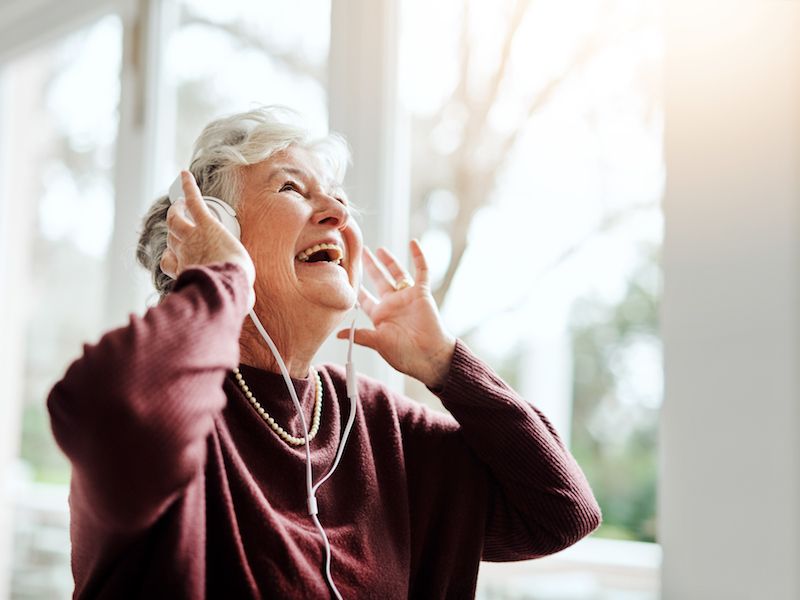
Individuals who work in loud surroundings like construction sites or at heavy metal concerts are not the only ones affected by noise related hearing loss. It doesn’t even need to be work-related, recreation-related noise exposure can be damaging, too. What kind of exposure are we discussing? Loud noise heard through headphones, whether it’s music, gaming, streaming video, or even an audiobook with the volume turned up.
You might not realize your smartphone or tablet can get that loud. The average pain threshold for human hearing is about 150 db which is well within the range of these devices. Your ears will literally start to hurt at this volume. So what can you do to safeguard against this type of noise-related loss of hearing?
It’s important here to think about the volume. Listen with the volume at or below 60% for no more than 60 minutes at a stretch (how long you listen for also matters), this is called the 60/60 rule.
Make a Setting on Your Hearing Aids For Music
Make certain, if you’re using hearing aids, you don’t try to drown out other sounds by turning your streaming music up too high. And there are better ways to listen to music so ask us about that also. If you’re a musician or someone who loves music you might have recognized that most hearing aids are programmed to enhance the clarity of voices…not necessarily music. We may be able to change the configuration to reduce noise and feedback while maximizing some frequency ranges to improve the quality of sound while listening to music.
What Are The Best Headphones For You?
If you don’t have hearing aids, there are many choices for buying headphones. It might be a matter of personal choice, but there are some things you should think about there too.
Headphones That go Over The Ears
Over the ear headphones are becoming popular again but you probably won’t find the old foam covered ear pieces that used to come with a walkman. They have a lot of options in color and style, are frequently endorsed by celebrities, and can be surprisingly costly. And these headphones go over the entire ear blocking out noise, unlike those old foam ones.
Conventional wisdom is that these are safer than in-ear headphones because the source of the sound is further from your eardrum. But because the speakers are larger they are commonly capable of much louder sound level. In addition, noise-canceling could possibly help you ignore the crying baby on your flight, but in other circumstances, it can silence sounds you should hear (like a honking car). Having said that, because they block out outside sound, you can typically reduce the volume of what you’re listening to so it’s not so loud that it will hurt your ears.
Earbuds
The standard earbuds are well known for inferior quality of sound, although many people still use them because hey, they came with the phone. Plus, with newer models that don’t have a headphone jack, sticking with Apple’s earbuds can just be easier.
The drawback, in addition to the poor sound quality, is that basic earbuds don’t block outside sounds, so you’re more likely to pump up the volume. Again, though it’s often said that earbuds are a problem because you stick them into your ear so their speakers are really close to your eardrum, volume is the biggest problem.
Noise Blocking Earbuds
More comfortable than ordinary earbuds, models that have a round rubber tip are the choice of many because they help obstruct outside noise. The rubber molds to the shape of your ear, producing a seal that blocks other sounds from getting in. Not to sound like a broken record, but these have the same disadvantages as the other two (volume is the main problem), as well as carrying the same caution as over-the-ear headphones (they can block out warning sounds). Needless to say, these won’t work for you if you wear hearing aids.
You may need to check out more than one pair before you find headphones that work for you. Depending on what you’re most often using them for say talking on the phone, versus listening to music, you’ll have different acoustic expectations. The relevant thing is to find headphones that make it comfortable for you to listen at a safe and secure sound level.
How to be Sure Your Hearing is Protected
Is it Safe, How Can I be Sure? There’s an app for that…If you have a smartphone, you can download the National Institute for Occupational Safety and Health’s free Sound Level Meter app. There are other apps out there, but research has discovered that the dependability of these other apps is spotty (additionally, for whatever reason, Android-based apps have proven to be less accurate). That motivated NIOSH to develop their own app. You can measure outside sounds with the app, but sounds coming out of your device’s speakers can also be measured, essentially, the true volume of what’s going to your ears. You have to put in a little effort, but taking these types of protective steps can help protect your hearing.